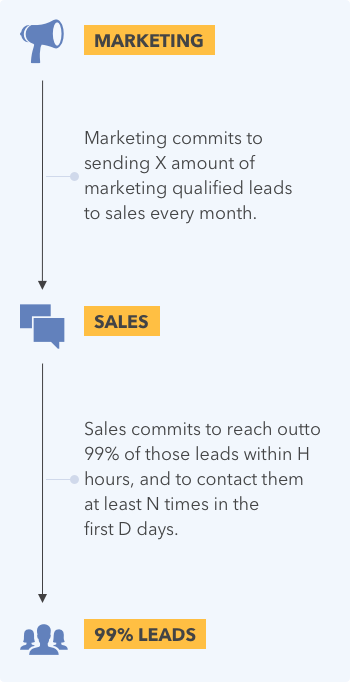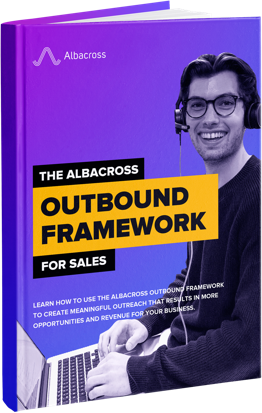It’s possible you already have a defined process in place for how you handle both inbound and outbound leads.
Typically, inbound leads will be sent to Sales Development Reps who will be tasked with qualifying the lead before passing it onto an Account Executive as an Opportunity.
Outbound Leads are typically handled by Business Development Reps or Outbound SDRs using prospecting and outreach tactics to generate interest.
Leads generated through Albacross - companies who have visited your website and have shown buying intent but have not converted through contact forms - are neither inbound or outbound leads.
They’re not technically inbound because they didn’t explicitly express interest by leaving their contact details or signing up for a free trial or demo.
However, they can’t be considered an outbound lead either because they have shown some level of interest by visiting your website. They know who you are.
We call this type of lead an intent lead. It’s the ability to identify these types of leads which make them different from regular inbound/outbound leads.

Intent leads need a hand off process just like every other type of lead.
They’ll either be sent to your marketing automation system to be distributed into nurture campaigns until they convert, targeted with ABM if this is your approach or they’ll be sent directly to your Sales team for prospecting.
It’s important to note the leads handed to your sales team also need nurturing. They may have visited your website and shown intent but there is still work to be done in order to get them to convert. That’s why we recommend you put intent leads into an outbound sequence.
In this guide, we’re focusing on how to follow up on intent leads using the Outbound Framework.
In the first instance, marketers will be responsible for the technical set up of Albacross’s tracking script on your website. This allows the data on which companies are visiting your website to be displayed in the Albacross platform.
Marketing will also be responsible for defining the target market segments, in accordance with your ideal customer profile (ICP) and buying intent activity. However, you should work closely together to determine what the ICP and intent looks like.
Let’s delve in deeper on ICPs and intent activity.
What is an ICP?
“An Ideal Customer Profile (ICP)* is a set of firmographic attributes that represent your organization’s most valuable customers.“
*A company-level ICP should not be confused with buyer personas who represent the individual buyers within the company.
An ICP allows you to focus on selling to targeted accounts that are a good fit for your organization. When it’s done correctly, it helps you identify the high value leads who visited your website.
To define your ICP, first make a list of your top 10 customers. What firmographic attributes do they have in common?
- ICP image
- Industries
- Revenue
- Location
- Employees
- Technology Stack
- Companies
- Decision makers (role)
Once you’ve evaluated the similarities your best customers have, you need to develop a company-fit model to see how well an account aligns with your ICP.
You can use this rating system to prioritize your ICPs which will aid in distributing sales resources and tactics, as well as identify future target companies.
Here’s an example of the company-fit model:
‘Dream’
company
Large software enterprise with 500+ employees in the UK, using Salesforce CRM.
‘Nice to have’
company
Large software enterprise with 200+ employees in Europe, using Salesforce CRM.
‘Won’t actively prospect’
company
Non-European Software companies with under 50+ employees.
In addition to defining your ICP for your segments in Albacross, you also need to consider intent activity. Let’s take a look at what this means.
What is Intent Activity Data?
When a prospect is showing buying intent it means they are likely to be considering making a purchase. For example, a returning visitor checking out your pricing page or a visitor who’s spent a long time on your product pages shows high buying intent.
You can use the benchmarks below to classify high intent data.
This is how we determine high intent at Albacross:
- Exclude converted / form inputs (you can do this in Albacross) - You only want to identify unconverted visitors
Pricing page visits
1 visit
Product page views
1 visit or more
Session duration
1 minute or more
- Relevant traffi�c sources (search, adwords, direct, Linkedin)
- UTM tags - Visits that came from your relevant marketing campaigns
*These benchmarks are based on our own conversion rates of unconverted website visitors.
Pro tip: Make your ICP and intent activity as niche as possible so that your SDRs only get the most relevant data. You can always amend your segments after a trial period.
Why is an ICP and Defined Intent Activity Criteria Important When Using Albacross?
Having a clearly defined ICP and intent activity criteria allows you to segment lead data in Albacross. This gives you the ability to pick out the leads that are likely to be the most pre-qualified and who present the biggest opportunity for your business.
In addition, it gives you the data you need to qualify intent leads - prospects that have expressed interest in your products and services on your website but have not identified themselves - to determine how you prioritize them and which outbound sequence you put them in.
For example, the dream companies who show buying intent will become the priority for your SDRs when it comes to prospecting. They’ll need to be fielded quickly to the relevant SDR for follow up.
On the other hand, leads that didn’t match the criteria can be put into an automated outbound sequence for nurture.
Understanding which leads need more focus allows your SDRs to prospect efficiently and effectively.
Intent Lead Distribution
Once the ICP and intent activity criteria have been set up, you as a Sales leader need to be involved in decisions around how the leads will be distributed to the sales teams for follow up.
For example, you could distribute the leads based on a number of criteria:
- Country
- Enterprise vs non-enterprise
- New vs existing customers
- Region
- SDR name
We most typically see customers fielding leads based on SDR and region/country. Depending on how you choose to field intent leads, your segments might look a little like this.
Note: Ensure you liaise with marketing so they understand how you want the lead data to be distributed as they are the team typically responsible for setting up segments in the platform.
Account Intelligence
In addition to intent data, Albacross can also provide Account Intelligence. Account Intelligence uses the same data to help Account Managers identify intent from existing accounts. This enables them to recognize potential upsell or cross sell opportunities when a customer visits your website. It also enhances communication during long lead cycles.
In this instance, you would distribute leads based on existing customers and/or by Account Manager name.
How Will Intent Leads be Distributed?
Typically, intent leads generated from Albacross will be distributed to SDRs in three formats:
Automatically created as leads/accounts/deals in your CRM and assigned to an SDR.

(Whether intent leads come in as leads/accounts/deals will depend on how you choose to set this up - liaise with marketing and your Customer Success Manager at Albacross on this). You will need to have an integration setup with Albacross to achieve this. Above is an example of how the data from Albacross might look in your CRM.
Slack notification.


The Slack-Albacross workflow will allow you to create specific channels for each SDR. This means the relevant people are notified instantly when a company of interest has visited your website.
Use Microsoft teams? You can also achieve this integration through web hooks. Ask your Customer Success Manager for more information.
List format in your CRM.
This is the active workflow list your SDRs will use to determine which outbound sequences the leads will go into. The list is updated automatically.
We recommend you use a sales engagement platform to handle intent leads you get from Albacross. A sales engagement platform such as Outreach or Salesloft allows you to create sequences for different types of leads. Since you’ll be creating various sequences for prospecting (based on the Agoge Sequence), the easiest way to manage prospecting - and keep data entry to a minimum - is to use a sales engagement platform.
Create a Sales-Marketing SLA
The data generated from Albacross impacts both marketing and sales. Ultimately, it helps to unify both teams. Therefore, it’s always a good idea to put a service level agreement in place to foster alignment and ensure the lead management process runs smoothly.
At a very top level, the SLA should outline the deliverables that both marketing and sales have. It will likely look something like this.










